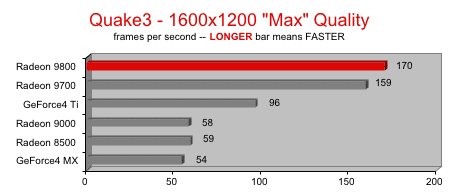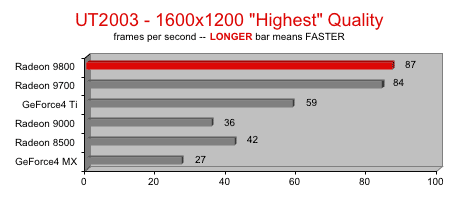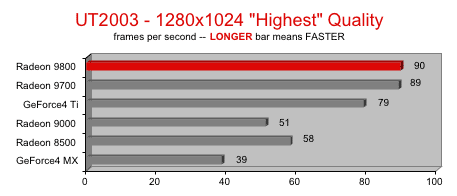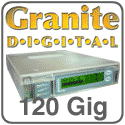
"BARE facts on Macintosh speed FEATS"
SmallDog.com has refurbished towers, laptops, displays, etc., with 12 month warranty.
|
|||||||||||||||||||||||||||||||||||||||||||||||||||||||
|
Originally posted 07/25/03 by rob-ART morgan, mad scientist If you recall my tests results posted on the 17th of July, the Radeon 9800 Pro was just a little faster than the GeForce4 Ti. At ATI's suggestion, I reran Quake3 and Unreal Tournament 2003 at 1600x1200.  I see why ATI asked me to do this. At 1024x768, the Radeon 9800 only had a 7% advantage over the Geforce4 Ti. At 1600x1200, the advantage jumps to 77%.
Again, I see the light. The Radeon 9800's jumps from an 8% DISadvantge to the GeForce4 Ti at 1024x768 to a 66% advantage at 1600x1200.
I also ran at 1280x1024 since some of you can't set your LCD or CRT display to 1600x1200. 
ANALYSIS 1. The higher rez test results made a believer out of me! If you are running professional 3D fly-throughs and "just for fun" 3D hardware accelerated games at high resolutions (1600x1200), 32 bit color, high quality texture/geometric settings, the Radeon 9800 Pro Mac Edition (and Radeon 9700 Pro) is MUCH faster than any other retail graphics card available for the Mac (past or present). It's likely that the G5 with its 8X AGP Pro slot, faster system bus and faster CPU will allow the BTO version of the Radeon 9800 Pro to go even faster. We will post the G5 results on this page as soon as we can get our sticky paws on one. 2. As I said above, at 1024x768, the Radeon 9800 only had a 7% advantage over the Geforce4 Ti (4600) when running Quake3. At 1600x1200, the advantage jumps to 77%. Running Unreal Tournament 2003, the Radeon 9800 jumps from an 8% DISadvantge to the GeForce4 Ti at 1024x768 to a 66% advantage at 1600x1200. 3. I complained in my previous article because the retail version of the Radeon 9800 Pro comes with DVI, VGA, and S-Video ports. Personally, I prefer the ADC/DVI configuration offered on Apple's BTO version for the G5 Power Mac. ATI believes that's what most retail buyers will want. If your email is any indication, they may be mistaken. Bare Feats readers voted 3 to 1 in favor of ADC/DVI. 9/10/03 -- Many of you have written me puzzled why ATI's retail Mac version of the Radeon 9800 Pro does not come with ADC connector and 8X support. I shared your puzzlement. Here's an explanation from ATI: "ADC for the G4 is different from the G5. The power connector on the motherboard is not in the same place. Therefore the following is true:G4 ADC cards will not fit into a G5 at all. 4. Since my 22" Cinema Display only runs at 1600x1024, I borrowed a ViewSonic VP211b 21" Flat Panel display. It's a very bright, clear screen. It even pivots 90 degrees. Why? So, along with ATI's Versavision software that comes with the Radeon 9800 Pro, you can easily convert the screen from a "landscape" to a "portrait" display. I prepared a chart below to highlight its features compared to the Apple 20" and 23" displays, as well as the Formac Gallery 2010
LINKS TO OTHER RADEON 9800 PRO TESTS WHERE TO BUY You can order the retail Radeon 9800 Pro Mac Edition (4X/2X AGP) direct from ATI's web site for $399. Ask about their trade-up program. The 9800 Pro for Mac will soon be available from Small Dog Electronics and from Buy.com. Visit the Apple Online Store to order your G5 Power Mac with the 8X Pro AGP version of the Radeon 9800 Pro. Apple 17", 20", and 23" LCD displays are available at the Apple Online Store or your local Apple dealer. The ViewSonic VP211b is available from Fry's Electronics store ($1399) or CompUSA ($1367). Or order online from Small Dog Electronics ($1499) or Buy.com ($1229 - search on "Viewsonic VP211b"). The Formac Gallery 2010 is available direct from Formac. TEST NOTES The Power Mac G4/1.42MP with 2GB of DDR memory and OS X (10.2.6) was the test mule. Cards tested on it included: nVidia GeForce2 MX
SEE "HOW WE TEST" for details on the tests reflected in the graphs.
|
MAIN INDEX PAGE
REVIEWS by Category
HOT DEALS on speed upgrades

Has Bare Feats helped you? Say "thanks"... with a donation.
![]()
Refurbs? Think Small. SmallDog.com
"BARE facts on Macintosh speed FEATS"
Email webmaster at rob-art@barefeats.com
(Bare Feats is hosted on a G4 Power Mac server by MacDock.com)
Has Bare Feats helped
you? Say "thanks"...
with a donation.







